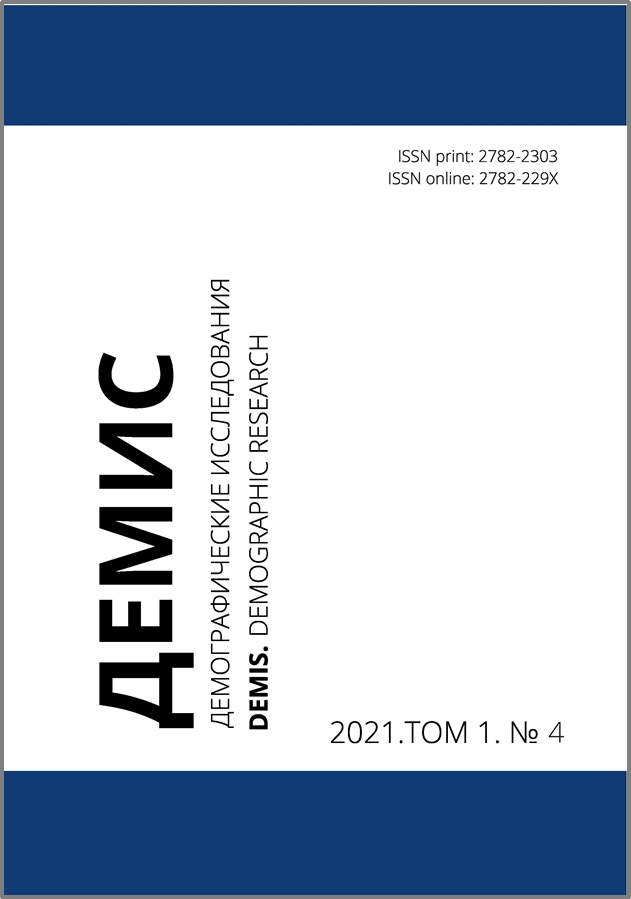Влияние пандемии COVID-19 на репродуктивные установки россиянок
Научная статья
Аннотация
Литература
2. Ионцев В. А. Современные особенности демографического развития России и ее регионов // Международный демографический форум: материалы заседания / отв. ред. д. г. н., проф. Н. В. Яковенко. – Воронеж: «Цифровая полиграфия», 2020. – С. 37–42.
3. Локосов В. В, Рыбаковский Л. Л., Рыбаковский О. Л., Басаев Г. Р. Результаты демографической политики и наступление демографической политики в России // Вестник Самарского государственного экономического университета. 2017. № 11 (157). С. 40–48.
4. Ионцев В. А., Прохорова Ю. А. Формирование «нового населения» в свете концепции четвертого демографического перехода // Вестник московского университета. Серия 6: Экономика. 2012. № 4. С. 75–87.
5. Энгельс Ф. Происхождение семьи, частной собственности и государства: [перевод с немецкого]. – М.: АСТ, 2019. – 288 с. ISBN: 978-5-17-118289-2.
6. Синельников А. Б. Трансформация брака и рождаемость в России // Народонаселение. 2019. № 2. С. 26–39. DOI: https://doi.org/10.24411/1561-7785-2019-00013.
7. Синельников А. Б. Значение брачности для семейно-демографической политики в России // Моделирование демографического развития и социально-экономическая эффективность реализации демографической политики России: материалы Международной научно-практической конференции (Москва, 3 декабря 2015 года) / Финансовый ун-т при Правительстве Российской Федерации, Ин-т социально-политических исслед. РАН; [отв. ред. - сост.: Рязанцев С. В., Письменная Е. Е.]. – Москва: Экономическое образование, 2015. – С. 115–124.
8. Миронов Б. Н. Русский город в 1740–1860-е годы: демографическое, социальное и экономическое развитие. – Ленинград: Наука, 1990. – 273 c. ISBN: 5-02-027273-6.
9. Nobles J., Frankenberg E., Thomas D. The Effects of Mortality on Fertility: Population Dynamics After a Natural Disaster. Demography. 2015. Vol. 52. No. 1. Pp. 15–38. doi: https://doi.org/10.1007/s13524-014-0362-1.
10. Zaba B., Gregson S. Measuring the Impact of HIV on Fertility in Africa. AIDS. 1998. Vol. 12. Suppl. 1. Pp. 41–50.
11. Boberg-Fazlic N., Ivets M., Karlsson M., Nilsson T. Disease and Fertility: Evidence from the 1918-19 Influenza Pandemic in Sweden. Economics & Human Biology. 2021. Vol. 43. DOI: https://doi.org/10.1016/j.ehb.2021.101020.
12. Mamelund S.-E. Can the Spanish Influenza Pandemic of 1918 Explain the Baby Boom of 1920 in Neutral Norway? Population. 2004. Vol. 59. No. 2. Pp. 229–260. DOI: https://doi.org/10.2307/3654904.
13. Siddharth C., Yan-Liang Y. The 1918 Influenza Pandemic and Subsequent Birth Deficit in Japan. Demographic Research. 2015. Vol. 33. No. 11. Pp. 313−326. DOI: https://doi.org/10.4054/DemRes.2015.33.11.
14. Anifandis G., Tempest H. G., Oliva R., Swanson G. M., Simopoulou M., Easley C. A., Primig M., Messini C. I., Turek P. J., Sutovsky P., Ory S. J., Krawetz S. A. COVID-19 and Human Reproduction: A Pandemic that Packs a Serious Punch. Systems Biology in Reproductive Medicine. 2021. Vol. 67. No. 1. Pp. 3–23. DOI: https://doi.org/10.1080/19396368.2020.1855271.
Поступила: 20.07.2021
Опубликована: 06.12.2021






